Corrosion Performance of Ti6Al7Nb Alloy in Simulated Body Fluid for Implant Application Characterized Using Macro- and Microelectrochemical Techniques
Abstract
1. Introduction
2. Materials and Methods
2.1. Materials
2.2. Methods
3. Results
3.1. Macroelectrochemical Characterization
3.2. Scanning Electrochemical Microscopy Measurements
4. Conclusions
Author Contributions
Funding
Institutional Review Board Statement
Informed Consent Statement
Data Availability Statement
Conflicts of Interest
References
- Geetha, M.; Singh, A.K.; Asokamani, R.; Gogia, A.K. Ti based biomaterials, the ultimate choice for orthopaedic implants—A review. Prog. Mater. Sci. 2009, 54, 397–425. [Google Scholar] [CrossRef]
- Kolli, R.P.; Devaraj, A. A review of metastable beta titanium alloys. Metals 2018, 8, 506. [Google Scholar] [CrossRef]
- Zhang, L.C.; Chen, L.Y. A review on biomedical titanium alloys: Recent progress and prospect. Adv. Eng. Mater. 2019, 21, 1801215. [Google Scholar] [CrossRef]
- Kaur, M.; Singh, K. Review on titanium and titanium based alloys as biomaterials for orthopaedic applications. Mater. Sci. Eng. C 2019, 102, 844–862. [Google Scholar] [CrossRef] [PubMed]
- Nicholson, J.W. Titanium alloys for dental implants: A review. Prosthesis 2020, 2, 100–116. [Google Scholar] [CrossRef]
- Chen, L.-Y.; Cui, Y.-W.; Zhang, L.-C. Recent Development in beta titanium alloys for biomedical applications. Metals 2020, 10, 1139. [Google Scholar] [CrossRef]
- Lu, J.; Zhang, Y.; Huo, W.; Zhang, W.; Zhao, Y.-Q. Electrochemical corrosion characteristics and biocompatibility of nanostructured titanium for implants. Appl. Surf. Sci. 2018, 434, 63–72. [Google Scholar] [CrossRef]
- Giner, M.; Olmo, A.; Hernández, M.; Trueba, P.; Chicardi, E.; Civantos, A.; Vázquez, M.A.; Montoya-García, M.-J.; Torres, Y. Use of impedance spectroscopy for the characterization of in-vitro osteoblast cell response in porous titanium bone implants. Metals 2020, 10, 1077. [Google Scholar] [CrossRef]
- Eliaz, N. Corrosion of metallic biomaterials: A review. Materials 2019, 12, 407. [Google Scholar] [CrossRef]
- Asserghine, A.; Filotás, D.; Nagy, L.; Souto, R.M.; Nagy, G. Do titanium biomaterials get immediately and entirely repassivated? A perspective. Npj Mater. Degradat. 2022, 6, 57. [Google Scholar] [CrossRef]
- Burstein, G.T.; Souto, R.M. Observations of localized instability of passive titanium in chloride solution. Electrochim. Acta 1995, 40, 1881–1888. [Google Scholar] [CrossRef]
- Souto, R.M.; Burstein, G.T. A preliminary investigation into the microscopic depassivation of passive titanium implant materials in vitro. J. Mater. Sci. Mater. Med. 1996, 7, 337–343. [Google Scholar] [CrossRef]
- Burstein, G.T.; Liu, C.; Souto, R.M. The effect of temperature on the nucleation of corrosion pits on titanium in Ringer’s physiological solution. Biomaterials 2005, 26, 245–256. [Google Scholar] [CrossRef]
- Mei, D.; Lamaka, S.V.; Lu, X.; Zheludkevich, M.L. Selecting medium for corrosion testing of bioabsorbable magnesium and other metals—A critical review. Corros. Sci. 2020, 171, 108722. [Google Scholar] [CrossRef]
- Contu, F.; Elsener, B.; Böhni, H. A study of the potentials achieved during mechanical abrasion and the repassivation rate of titanium and Ti6Al4V in inorganic buffer solutions and bovine serum. Electrochim. Acta 2004, 50, 33–41. [Google Scholar] [CrossRef]
- Izquierdo, J.; Bolat, G.; Mareci, D.; Munteanu, C.; González, S.; Souto, R.M. Electrochemical behaviour of ZrTi alloys in artificial physiological solution simulating in vitro inflammatory conditions. Appl. Surf. Sci. 2014, 313, 259–266. [Google Scholar] [CrossRef]
- Wang, J.-L.; Liu, R.L.; Majumdar, T.; Mantri, S.A.; Ravi, V.A.; Banerjee, R.; Birbilis, N. A closer look at the in vitro electrochemical characterisation of titanium alloys for biomedical applications using in-situ methods. Acta Biomater. 2017, 54, 469–478. [Google Scholar] [CrossRef]
- Asserghine, A.; Medvidović-Kosanović, M.; Nagy, L.; Nagy, G. In situ monitoring of the transpassivation and repassivation of the passive film on nitinol biomaterial by scanning electrochemical microscopy. Electrochem. Commun. 2019, 107, 106539. [Google Scholar] [CrossRef]
- Asserghine, A.; Medvidović-Kosanović, M.; Nagy, L.; Souto, R.M.; Nagy, G. A study of the electrochemical reactivity of titanium under cathodic polarization by means of combined feedback and redox competition modes of scanning electrochemical microscopy. Sens. Actuators B Chem. 2020, 320, 128339. [Google Scholar] [CrossRef]
- Li, X.-R.; Zhang, Q.-H.; Meng, X.-Z.; Wu, L.-K.; Cao, F.-H. Effect of pretreatments on the hydrogen evolution kinetics of pure titanium using impedance and SECM technologies. Corros. Sci. 2021, 191, 109726. [Google Scholar] [CrossRef]
- de Assis, S.L.; Wolynec, S.; Costa, I. Corrosion characterization of titanium alloys by electrochemical techniques. Electrochim. Acta 2006, 51, 1815–1819. [Google Scholar] [CrossRef]
- Vasilescu, E.; Drob, P.; Raducanu, D.; Cinca, I.; Mareci, D.; Calderon Moreno, J.M.; Popa, M.; Vasilescu, C.; Mirza Rosca, J.C. Effect of thermo-mechanical processing on the corrosion resistance of Ti6Al4V alloys in biofluids. Corros. Sci. 2009, 51, 2885–2896. [Google Scholar] [CrossRef]
- Karimi, S.; Alfantazzi, A.M. Electrochemical corrosion behavior or orthopedic biomaterials in presence of human serum albumin. J. Electrochem. Soc. 2013, 160, C206–C214. [Google Scholar] [CrossRef]
- Jimenez-Marcos, C.; Mirza-Rosca, J.C.; Baltatu, M.S.; Vizureanu, P. Experimental research on new developed titanium alloys for biomedical applications. Bioengineering 2022, 9, 686. [Google Scholar] [CrossRef]
- Aziz-Kerrzo, M.; Conroy, K.G.; Fenelon, A.M.; Farrell, S.T.; Breslin, C.B. Electrochemical studies on the stability and corrosion resistance of titanium-based implant materials. Biomaterials 2001, 22, 1531–1539. [Google Scholar] [CrossRef] [PubMed]
- Moisel, M.; Lorenzo de Mele, M.A.F.; Müller, W.-D. Biomaterial interface investigated by electrochemical impedance spectroscopy. Adv. Eng. Mater. 2008, 10, B33–B46. [Google Scholar] [CrossRef]
- Civantos, A.; Martínez-Campos, E.; Ramos, V.; Elvira, C.; Gallardo, A.; Abarrategi, A. Titanium coatings and surface modifications: Toward clinically useful bioactive implants. ACS Biomater. Sci. Eng. 2017, 3, 1245–1261. [Google Scholar] [CrossRef]
- Prando, D.; Fajardo, S.; Pedeferri, M.; Ormellese, M. Titanium anodization efficiency through real-time gravimetric measurement of oxygen evolution. J. Electrochem. Soc. 2020, 167, 061507. [Google Scholar] [CrossRef]
- Singh, R.; Dahotre, N.B. Corrosion degradation and prevention by surface modification of biometallic materials. J. Mater. Sci. Mater. Med. 2007, 18, 725–751. [Google Scholar] [CrossRef] [PubMed]
- Niespodziana, K.; Jurczyk, K.; Jurczyk, M. The synthesis of titanium alloys for biomedical applications. Rev. Adv. Mater. Sci. 2008, 18, 236–240. [Google Scholar]
- Ribeiro, A.L.; Junior, R.C.; Cardoso, F.F.; Fernandes Filho, R.B.; Vaz, L.G. Mechanical, physical, and chemical characterization of Ti–35Nb–5Zr and Ti–35Nb–10Zr casting alloys. J. Mater. Sci. Mater. Med. 2009, 20, 1629–1636. [Google Scholar] [CrossRef]
- Azadbakht, R.; Almasi, T.; Keypour, H.; Rezaeivala, M. A new asymmetric Schiff base system as fluorescent chemosensor for Al3+ ion. Inorg. Chem. Commun. 2013, 33, 63–67. [Google Scholar] [CrossRef]
- Aksakal, B.; Yildirim, Ö.S.; Gul, H. Metallurgical failure analysis of various implant materials used in orthopedic applications. J. Fail. Anal. Prev. 2004, 4, 17–23. [Google Scholar] [CrossRef]
- Mystkowska, J.; Niemirowicz-Laskowska, K.; Łysik, D.; Tokajuk, G.; Dąbrowski, J.R.; Bucki, R. The role of oral cavity biofilm on metallic biomaterial surface destruction–corrosion and friction aspects. Int. J. Mol. Sci. 2018, 19, 743. [Google Scholar] [CrossRef]
- Mareci, D.; Ungureanu, G.; Aelenei, D.M.; Mirza Rosca, J.C. Electrochemical characteristics of titanium based biomaterials in artificial saliva. Mater. Corros. 2007, 58, 848–856. [Google Scholar] [CrossRef]
- Metikoš-Huković, M.; Kwokal, A.; Piljac, J. The influence of niobium and vanadium on passivity of titanium-based implants in physiological solution. Biomaterials 2003, 24, 3765–3775. [Google Scholar] [CrossRef] [PubMed]
- Neaga, V.; Benea, L.; Axente, E.R. Corrosion assessment of Zr2.5Nb alloy in Ringer’s solution by electrochemical methods. Appl. Sci. 2022, 12, 7976. [Google Scholar] [CrossRef]
- Chin, P.Y.Y.; Cheok, Q.; Glowacz, A.; Caesarendra, W. A review of in-vivo and in-vitro real-time corrosion monitoring systems of biodegradable metal implants. Appl. Sci. 2020, 10, 3141. [Google Scholar] [CrossRef]
- Payne, N.A.; Stephens, L.I.; Mauzeroll, J. The application of scanning electrochemical microscopy to corrosion research. Corrosion 2017, 73, 759–780. [Google Scholar] [CrossRef]
- Izquierdo, J.; González-Marrero, M.B.; Bozorg, M.; Fernández-Pérez, B.M.; Vasconcelos, H.C.; Santana, J.J.; Souto, R.M. Multiscale electrochemical analysis of the corrosion of titanium and nitinol for implant applications. Electrochim. Acta 2016, 203, 366–378. [Google Scholar] [CrossRef]
- Asserghine, A.; Medvidović-Kosanović, M.; Stanković, A.; Nagy, L.; Souto, R.M.; Nagy, G. A scanning electrochemical microscopy characterization of the localized corrosion reactions occurring on nitinol in saline solution after anodic polarization. Sens. Actuator B Chem. 2020, 321, 128610. [Google Scholar] [CrossRef]
- Pust, S.E.; Scharnweber, D.; Baunak, S.; Wittstock, G. Electron transfer kinetics at oxide films on metallic biomaterials. J. Electrochem. Soc. 2007, 154, C508–C514. [Google Scholar] [CrossRef]
- Pust, S.E.; Scharnweber, D.; Nunes Kirchner, C.; Wittstock, G. Heterogeneous distribution of reactivity on metallic biomaterials: Scanning probe microscopy studies of the biphasic Ti alloy Ti6Al4V. Adv. Mater. 2007, 19, 878–882. [Google Scholar] [CrossRef]
- Asserghine, A.; Filotás, D.; Nagy, L.; Nagy, G. Scanning electrochemical microscopy investigation of the rate of formation of a passivating TiO2 layer on a Ti G4 dental implant. Electrochem. Commun. 2017, 83, 33–35. [Google Scholar] [CrossRef]
- Santana, J.J.; Izquierdo, J.; Souto, R.M. Uses of scanning electrochemical microscopy (SECM) for the characterization with spatial and chemical resolution of thin surface layers and coating systems applied on metals: A review. Coatings 2022, 22, 637. [Google Scholar] [CrossRef]
- Rondelli, G.; Vicentini, B. Effect of copper on the localized corrosion resistance of Ni-Ti shape memory alloy. Biomaterials 2002, 23, 639–644. [Google Scholar] [CrossRef]
- Burstein, G.T.; Liu, C.; Souto, R.M.; Vines, S.P. Origins of pitting corrosion. Corros. Eng. Sci. Technol. 2004, 39, 25–30. [Google Scholar] [CrossRef]
- Lavos-Valereto, I.C.; Wolynec, S.; Ramires, I.; Guastaldi, A.C.; Costa, I. Electrochemical impedance spectroscopy characterization of passive film formed on implant Ti–6Al–4V alloy in Hank’s solution. J. Mater. Sci. Mater. Med. 2004, 15, 55–59. [Google Scholar] [CrossRef] [PubMed]
- Vivier, V.; Orazem, M.E. Impedance analysis of electrochemical systems. Chem. Rev. 2022, 122, 11131–11168. [Google Scholar] [CrossRef]
- Wang, B.I.; Zheng, Y.F.; Zhao, I.C. Effects of Hf content and immersion time on electrochemical behaviour of biomedical Ti-22Nb-xHf alloys in 0.9% NaCl solution. Mater. Corros. 2009, 60, 330–335. [Google Scholar] [CrossRef]
- González-García, Y.; Burstein, G.T.; González, S.; Souto, R.M. Imaging metastable pits on austenitic stainless steel in situ at the open-circuit corrosion potential. Electrochem. Commun. 2004, 6, 637–642. [Google Scholar] [CrossRef]
- Izquierdo, J.; Martín-Ruíz, L.; Fernández-Pérez, B.M.; Fernández-Mérida, L.; Santana, J.J.; Souto, R.M. Imaging local surface reactivity on stainless steels 304 and 316 in acid chloride solution using scanning electrochemical microscopy and the scanning vibrating electrode technique. Electrochim. Acta 2014, 134, 167–175. [Google Scholar] [CrossRef]

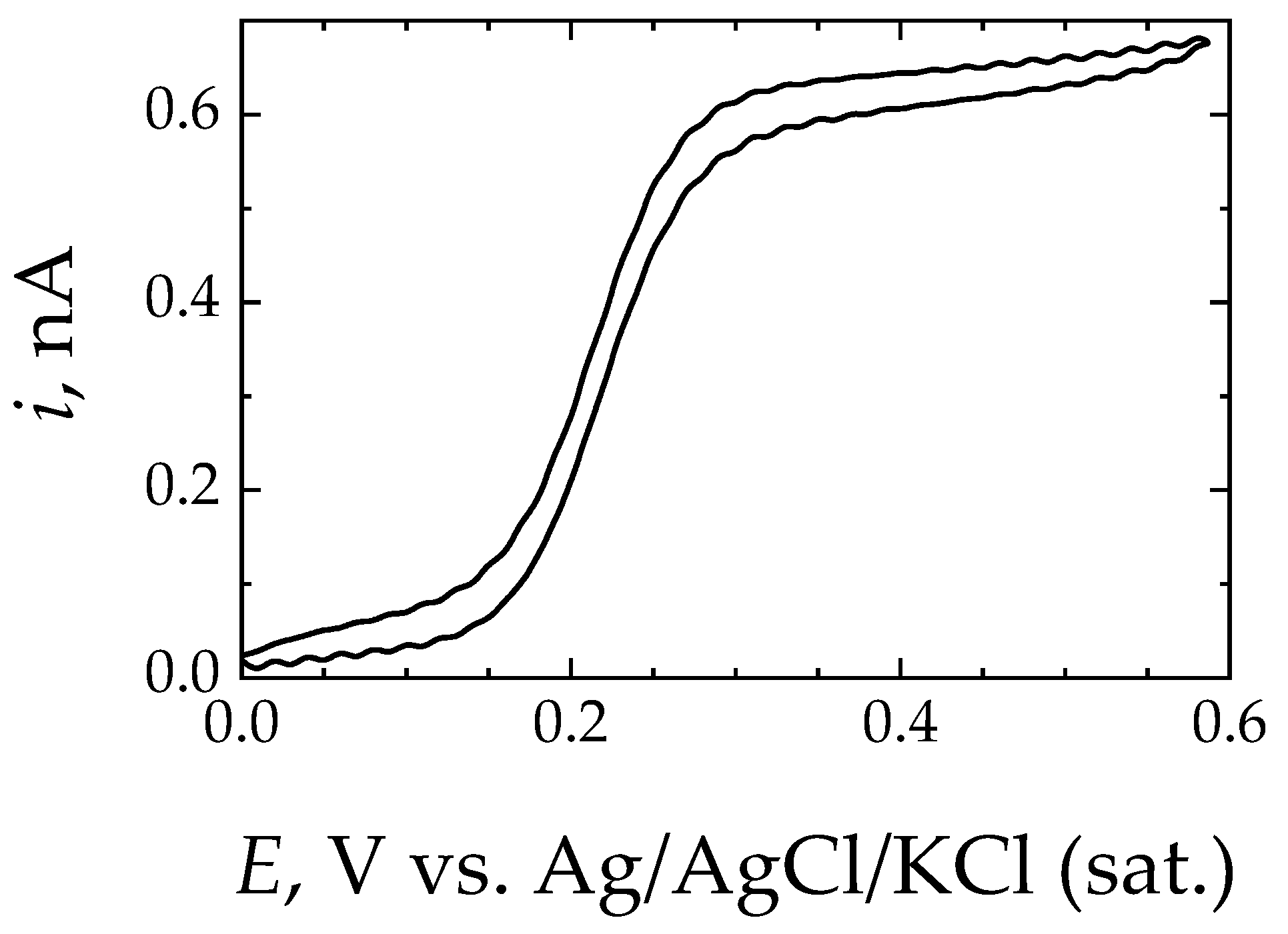

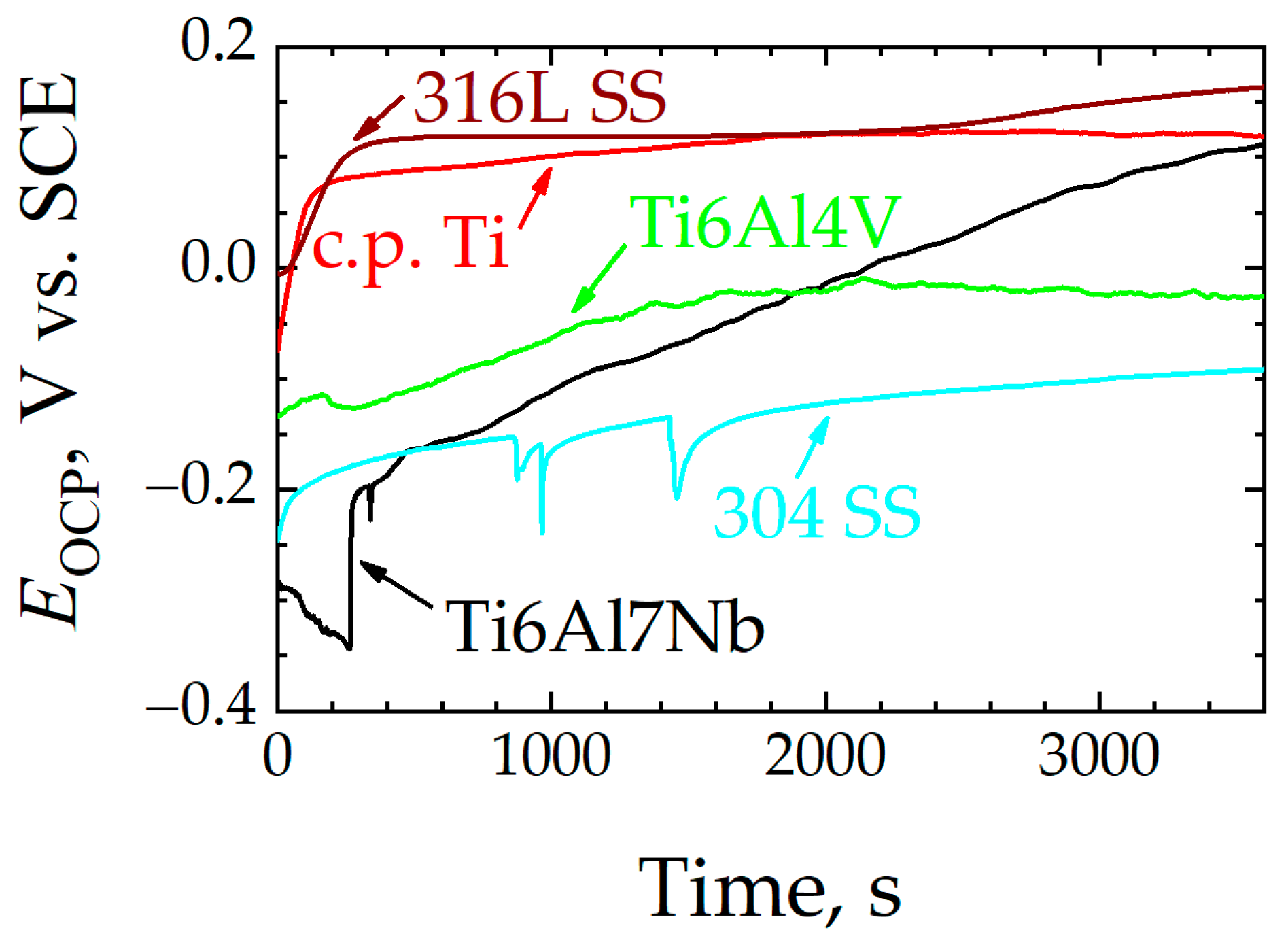
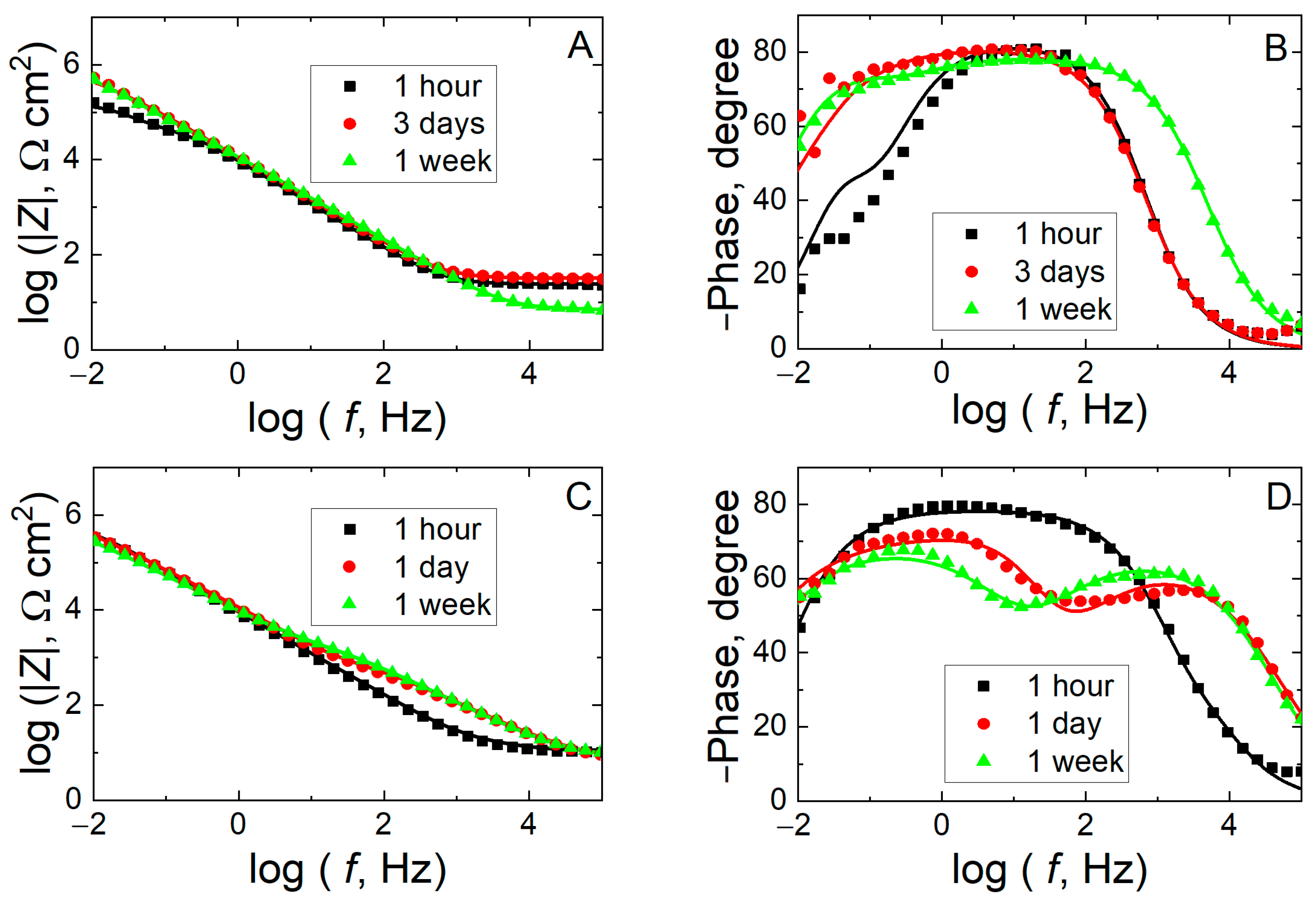
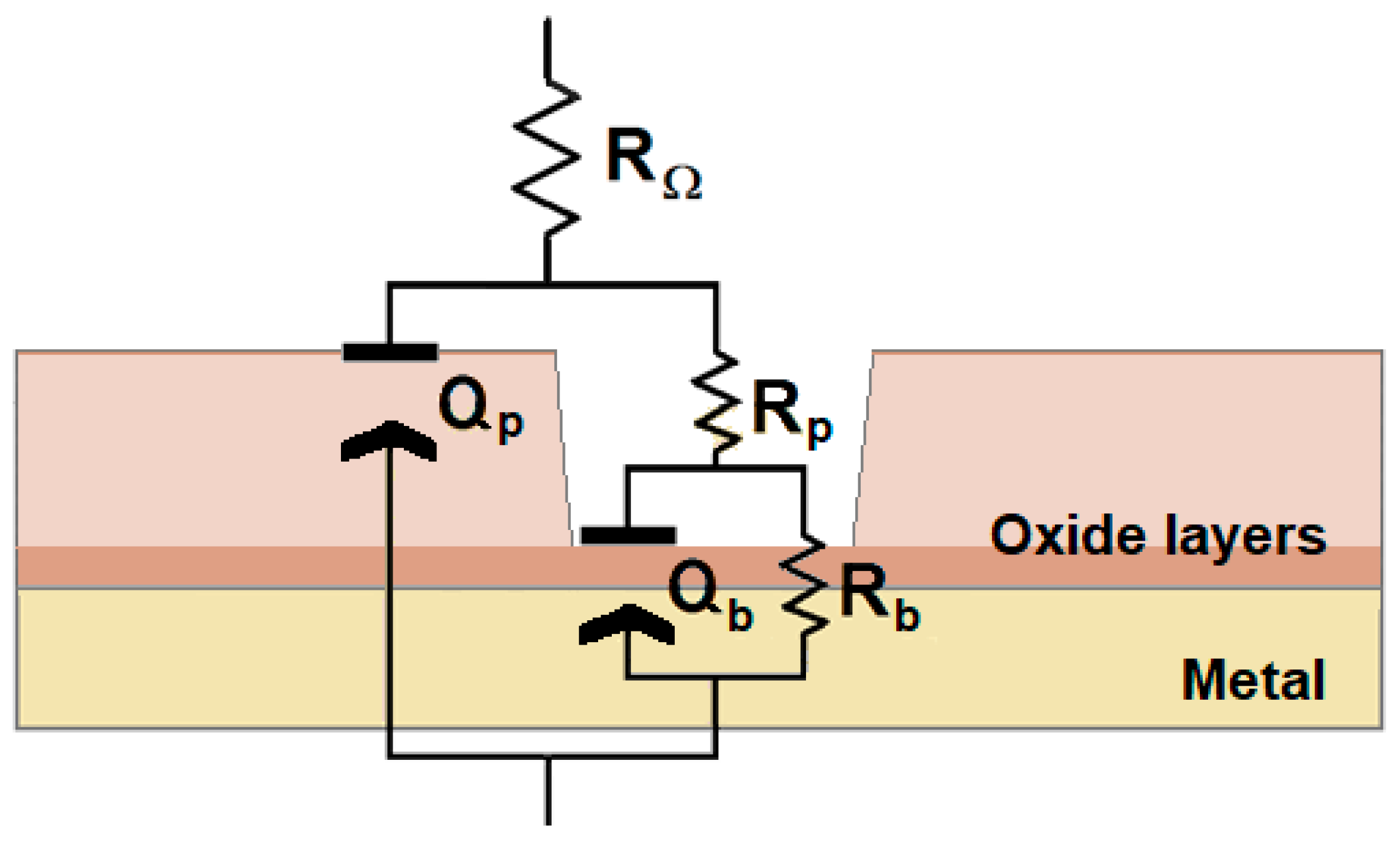
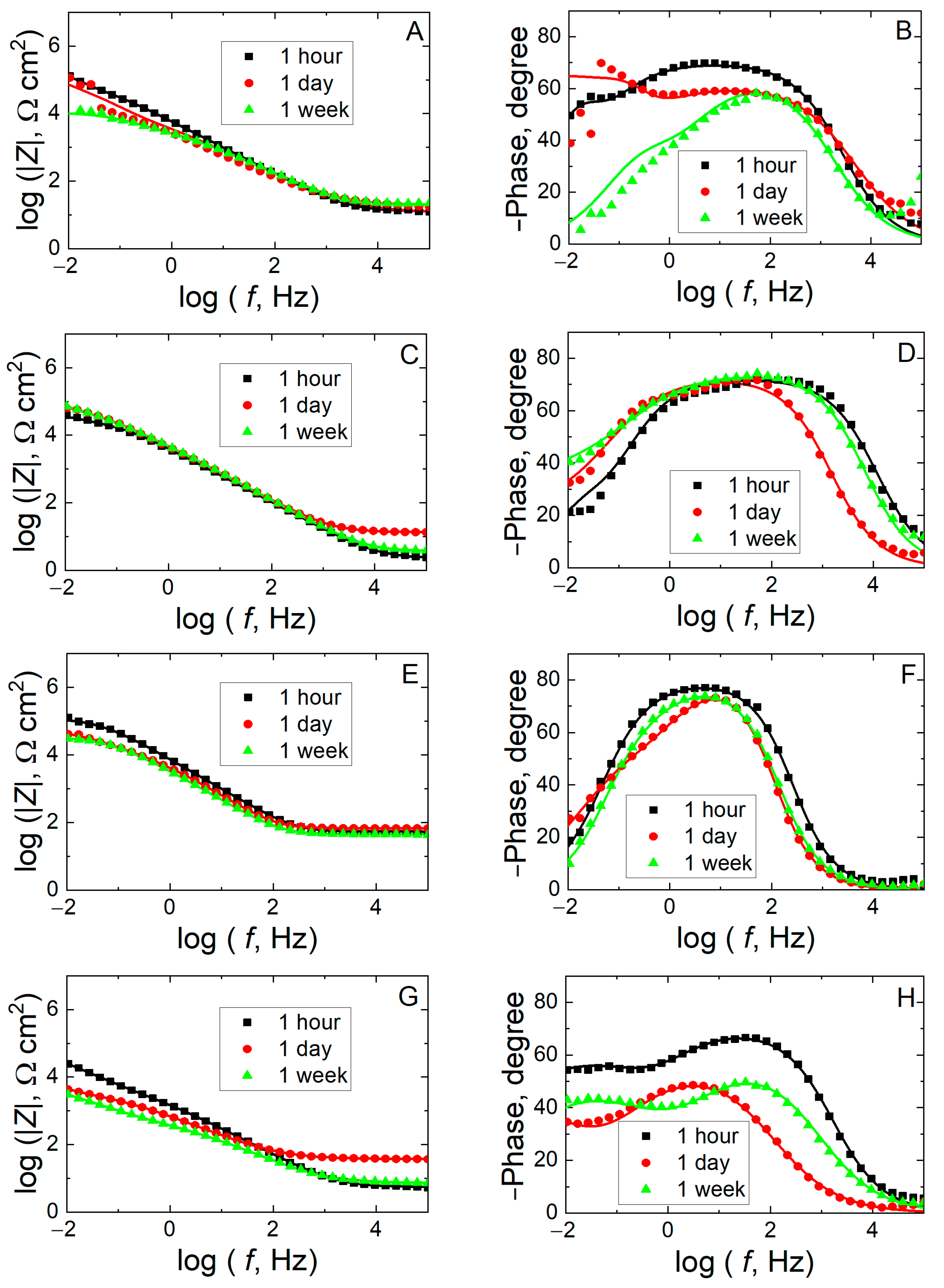

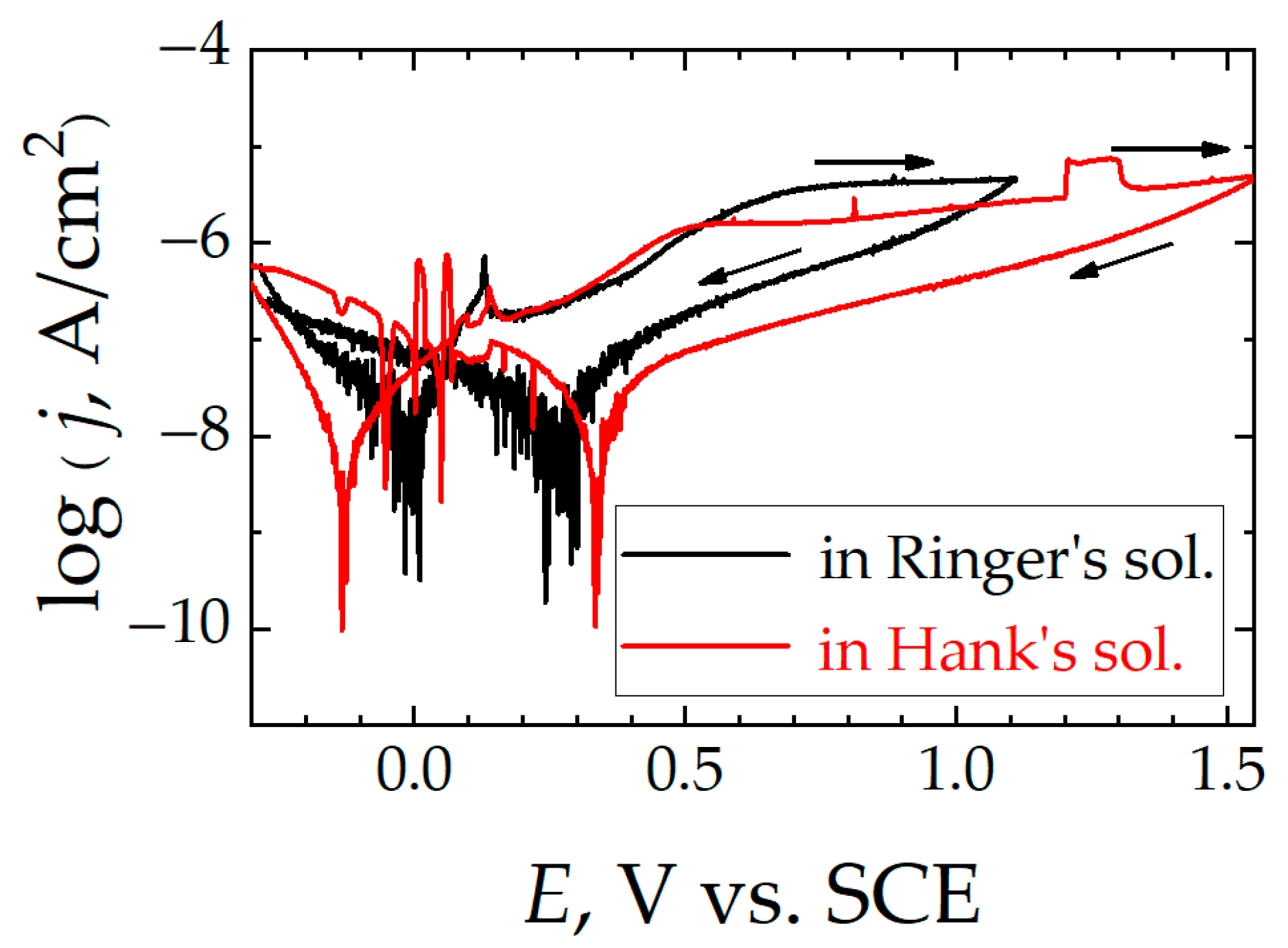
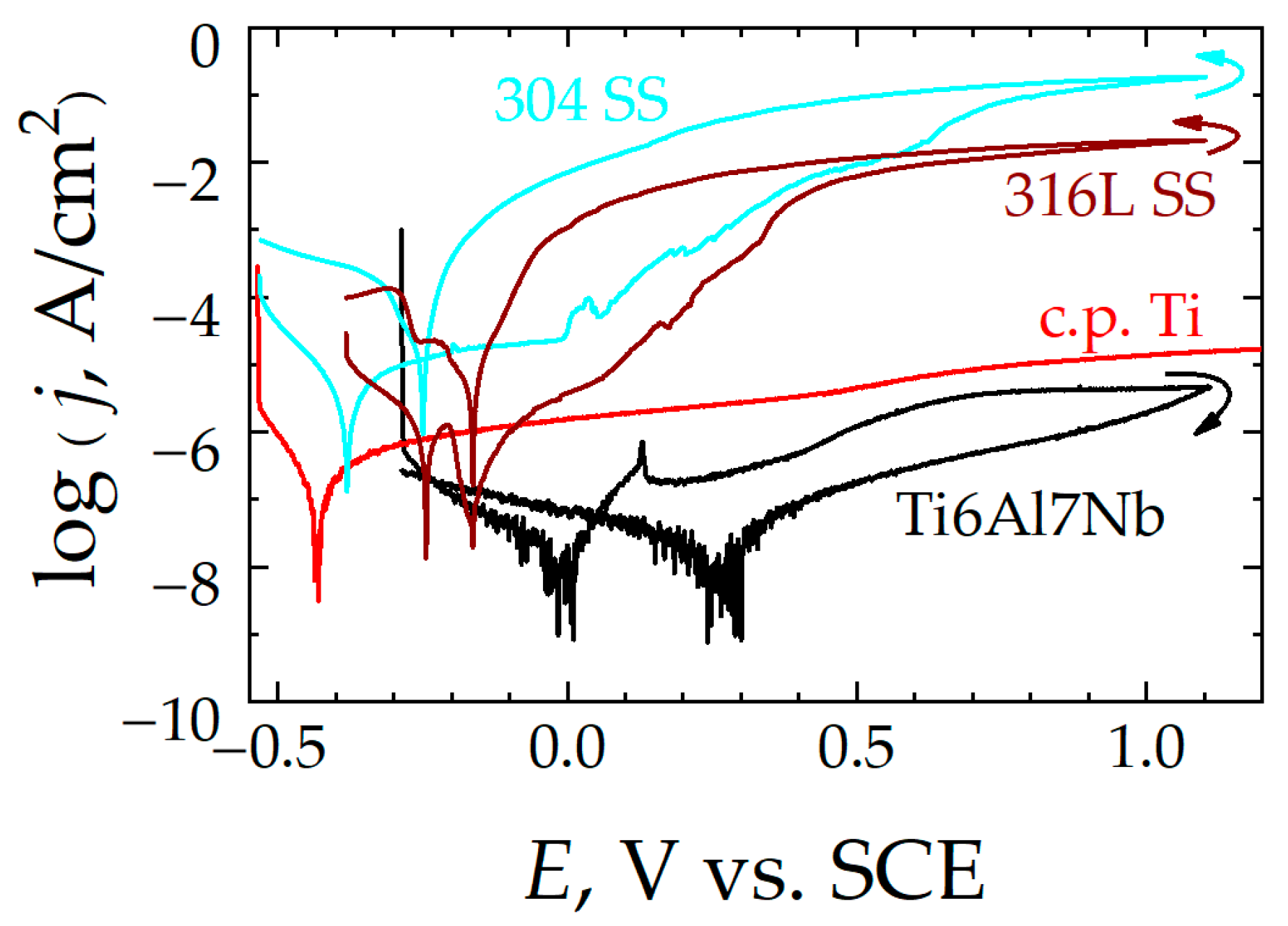


| Solution | Immersion Time/h | Rp/kΩ cm2 | 105 Qp/ S cm−2 sn | np | Rb/ kΩ cm2 | 105 Qb/ S cm−2 sn | nb |
|---|---|---|---|---|---|---|---|
| Ringer’s | 1 | 63.6 ± 13.8 | 1.85 ± 0.14 | 0.92 ± 13.8 | 94.7 ± 43.13 | 8.82 ± 6.19 | 1.00 ± 0.32 |
| 72 | 38.8 ± 7.2 | 1.23 ± 0.07 | 0.95 ± 0.01 | 835 ± 59 | 1.12 ± 0.16 | 0.84 ± 0.12 | |
| 168 | 197 ± 120 | 1.70 ± 0.06 | 0.87 ± 0.01 | 1057 ± 143 | 0.40 ± 0.14 | 0.90 ± 0.13 | |
| Hank’s | 1 | 0.022 ± 0.020 | 1.21 ± 1.49 | 0.88 ± 0.10 | 721 ± 20 | 1.01 ±1.48 | 0.72 ± 0.02 |
| 24 | 1.42 ± 0.20 | 1.51 ± 0.09 | 0.73 ± 0.01 | 1722 ± 109 | 0.60 ± 0.11 | 0.92 ± 0.04 | |
| 168 | 3.20 ± 0.65 | 1.34 ± 0.15 | 0.74 ± 0.01 | 978 ± 80 | 1.36 ± 0.16 | 0.78 ± 0.02 |
| Sample | Immersion Time/h | Rp/ kΩ cm2 | 105 Qp/ S cm−2 sn | np | Rb/ kΩ cm2 | 105 Qb/ S cm−2 sn | nb |
|---|---|---|---|---|---|---|---|
| c.p. Ti | 1 | 19.6 ± 17.6 | 6.22 ± 3.01 | 0.80 ± 0.06 | 30.2 ± 26.5 | 32.3 ± 69.4 | 0.82 ± 0.41 |
| 24 | 69.8 ± 4.1 | 4.55 ± 0.22 | 0.81 ± 0.01 | 98.3 ± 13.1 | 75.4 ± 11.8 | 1.00 ± 0.13 | |
| 168 | 17.9 ± 7.54 | 4.16 ± 0.13 | 0.82 ± 0.12 | 2027 ± 3070 | 3.50 ± 0.60 | 0.40 ± 0.05 | |
| Ti6Al4V | 1 | 110 ± 20 | 4.00 ± 0.16 | 0.78 ± 0.01 | 222 ± 44 | 6.23 ± 3.43 | 1.00 ± 0.17 |
| 24 | 10.3 ± 5.2 | 8.14 ± 1.00 | 0.67 ± 0.01 | 1050 ± 210 | 14.8 ± 3.7 | 1.00 ± 0.10 | |
| 168 | 3.48 ± 1.48 | 5.40 ± 0.98 | 0.73 ± 0.02 | 7.49 ± 2.76 | 14.1 ± 4.94 | 0.72 ± 0.22 | |
| 316L SS | 1 | 50.7 ± 10.6 | 2.53 ± 0.22 | 0.89 ± 0.01 | 74.2 ± 5.2 | 0.94 ± 0.07 | 0.42 ± 0.09 |
| 24 | 7.54 ± 1.70 | 3.53 ± 0.16 | 0.92 ± 0.01 | 60.5 ± 7.3 | 6.05 ± 0.56 | 0.58 ± 0.05 | |
| 168 | 6.61 ± 1.16 | 3.51 ± 0.11 | 0.92 ± 0.01 | 72.1 ± 7.1 | 5.93 ± 0.34 | 0.53 ± 0.03 | |
| 304 SS | 1 | 3.69 ± 0.67 | 12.8 ± 0.54 | 0.78 ± 0.01 | 258 ± 38.2 | 14.2 ± 0.82 | 0.63 ± 0.02 |
| 24 | 3.43 ± 0.41 | 40.9 ± 1.8 | 0.64 ± 0.01 | 28.3 ± 9.2 | 164 ± 41 | 0.64 ± 0.07 | |
| 168 | 0.44 ± 0.08 | 42.0 ± 4.3 | 0.67 ± 0.01 | 13.9 ± 1.9 | 113 ± 6.7 | 0.57 ± 0.03 |
| Sample and Solution | Ecor, V vs. SCE | jcor, A/cm2 | jpas, A/cm2 | Erep, V vs. SCE |
|---|---|---|---|---|
| Ti6Al7Nb in Hank’s | −0.132 | 1.25 × 10−8 | 1.58 × 10−6 | − |
| Ti6Al7Nb in Ringer’s | +0.090 | 1.12 × 10−7 | 3.16 × 10−6 | − |
| Ti6Al4V in Ringer’s | −0.183 | 9.47 × 10−8 | 5.01 × 10−7 | − |
| c.p. Ti in Ringer’s | −0.498 | 7.52 × 10−7 | 1.60 × 10−6 | − |
| 316L SS in Ringer’s | −0.185 | 2.78 × 10−7 | 4.07 × 10−6 | +0.654 |
| 304 SS in Ringer’s | −0.354 | 4.18 × 10−6 | 2.04 × 10−5 | +0.550 |
Disclaimer/Publisher’s Note: The statements, opinions and data contained in all publications are solely those of the individual author(s) and contributor(s) and not of MDPI and/or the editor(s). MDPI and/or the editor(s) disclaim responsibility for any injury to people or property resulting from any ideas, methods, instructions or products referred to in the content. |
© 2023 by the authors. Licensee MDPI, Basel, Switzerland. This article is an open access article distributed under the terms and conditions of the Creative Commons Attribution (CC BY) license (https://creativecommons.org/licenses/by/4.0/).
Share and Cite
Abreu-García, A.; Souto, R.M.; Izquierdo, J. Corrosion Performance of Ti6Al7Nb Alloy in Simulated Body Fluid for Implant Application Characterized Using Macro- and Microelectrochemical Techniques. Coatings 2023, 13, 1121. https://doi.org/10.3390/coatings13061121
Abreu-García A, Souto RM, Izquierdo J. Corrosion Performance of Ti6Al7Nb Alloy in Simulated Body Fluid for Implant Application Characterized Using Macro- and Microelectrochemical Techniques. Coatings. 2023; 13(6):1121. https://doi.org/10.3390/coatings13061121
Chicago/Turabian StyleAbreu-García, Andrea, Ricardo M. Souto, and Javier Izquierdo. 2023. "Corrosion Performance of Ti6Al7Nb Alloy in Simulated Body Fluid for Implant Application Characterized Using Macro- and Microelectrochemical Techniques" Coatings 13, no. 6: 1121. https://doi.org/10.3390/coatings13061121
APA StyleAbreu-García, A., Souto, R. M., & Izquierdo, J. (2023). Corrosion Performance of Ti6Al7Nb Alloy in Simulated Body Fluid for Implant Application Characterized Using Macro- and Microelectrochemical Techniques. Coatings, 13(6), 1121. https://doi.org/10.3390/coatings13061121







